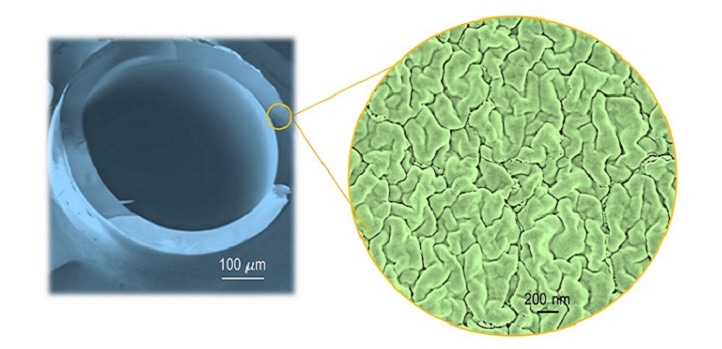Mar 12 2019
The environmental credentials of the chemical industry could be greatly enhanced by the selectively permeable membranes derived from renewable plant-based materials. A research team at KAUST has tested the viability of cellulose membranes to demonstrate that they can successfully clean wastewater.
 The team created well-formed cellulose hollow-fiber membranes for separating oil-in-water mixtures. (Image credit: KAUST)
The team created well-formed cellulose hollow-fiber membranes for separating oil-in-water mixtures. (Image credit: KAUST)
The use of polymer membranes to separate mixtures is typical in desalination, where seawater passed through membranes turns drinkable as the membrane filters the salt. Analogous membranes are being used by the chemical industry as a green technique for the purification of products or cleaning up waste. However, the membranes are usually developed by dissolving polymers in toxic, volatile organic solvents.
The main objective of KAUST Professor Suzana Nunes is finding a replacement to these solvents. A promising replacement investigated by Nunes and her colleagues is nonvolatile solvents known as ionic liquids, which can have a considerably minimal environmental impact when compared to organic solvents. In addition, they can dissolve membrane starting materials that are hard to dissolve in organic solvents, for example, cellulose.
Cellulose is an abundant natural polymer which can be sourced from plants and bacteria.
DooLi Kim, Postdoc, University of Twente.
Kim was a former PhD student from Nunes’ team.
The advantages of cellulose, such as its sustainability and very strong but chemically tunable structure, make it a very efficient green membrane material.
In their most recent study, Nunes tested the usability of cellulose membranes, cast from ionic liquids, to purify oily wastewater.
Oily wastewater is one of the biggest by-products of chemical, petrochemical and food industries. In regions such as Saudi Arabia, where the oil and gas industries are dominant, maximum oil removal from oil-in-water emulsions is an attractive concept.
Sara Livazovic, Dow Chemical.
Livazovic was a former PhD student from Nunes’ team and joined Dow Chemical after graduating.
The cellulose membranes developed by the researchers were very effective in separating oil-in-water mixtures. “Cellulose membranes prepared with hydrophilic ionic liquid showed almost 100 percent removal of crude oil from oil-in-water emulsions,” stated Livazovic.
“The cellulose based membrane had incredible antibiofouling performance,” Kim adds. Due to its hydrophilic surface, fewer oil deposits adhered to the membrane, and those adhered oil deposits were eluted easily.
The high cost of ionic liquids, when compared to organic solvents, is one remaining barrier. However, the team had earlier demonstrated that ionic liquids can be recovered up to 99% through simple steps such as distillation.
If recovered ionic liquids can be reapplied in the membrane manufacturing process, production costs will be reduced and the process would be even more eco-friendly.
DooLi Kim, Postdoc, University of Twente.